But, dear reader, should you? Is it worth tracking down one of Yamaha’s cheerful little runabouts for your next custom project? Has the bike become a staple of the scene because of its own merits, or is it just a cheap, uninspiring start to a project?
Well, we’re here to help you find out, in our latest Cafe Contenders review.
For the sake of readability, I’ll be referring to both iterations of the Yamaha SR as the SR400. It’s the one that’s been in production for the longest, but just about everything I’ll ramble on about is relevant to its bigger brother. Forget about the little SR250 for the moment – that’s a completely different beast.
BORN IN THE DIRT
The SR400 is essentially a road-going version of Yamaha’s XT and TT500 series of enduro bikes. Released in 1976 the 499cc single was the first off-road four-stroke produced by Yamaha and they sold mountains of them. All around the globe mud-caked enduro nuts bought and abused Yamaha’s new offering, finding them reliable, tractable, and cheap.
So in 1978 Yamaha capitalized on the fanfare around the XT with a road going version – the SR. Unfortunately, in most of the west, it was a disaster. In America, it was sold for only four short years, at only a trickle, before being run out in 1981 with examples gathering dust in the showroom for years afterward. It became a curio, a discount run-out special sold to the desperate and the eccentric. Sure, it proved exceptionally popular in some parts of the world – chiefly Japan and Germany. But in general, the little choked-up single wasn’t suited for American riders. In stock trim, it’s slow and runs out of breath at US highway speeds – a complete oddity when stacked against multi-cylinder bikes that came to define the late 70’s and early 80’s.
Imagine it’s 1980 and you’re standing in a showroom, looking at a spanking new Kawasaki Z1000 or Honda CB900C. And then you wander over, cigarette in hand, to look at the SR500. Why would you pick a roadgoing trail bike when, for not much more money, you could get three more cylinders, a whole lot more horsepower and an early funeral?
SO WHAT THE HELL HAPPENED?
Now the bike is everywhere – and it’s largely due to the Japanese. Over there the model soldiered on after capturing the imagination of the custom scene. It’s handling and horsepower are perfectly suited their roads, which have speed limits capped at 80km/h, and with a drop to 400cc to better suit local licensing laws SR400’s sold by the truckload.
As a result, an incredible amount of parts have become available for the SR400 and SR500 in Japan. We’re talking seats, exhaust systems, fuel tanks, gauges – everything you can imagine has been made for the bike. I’d the range of parts would give the entire Harley line a run for its money, although I’m yet to find a leather-tasseled seat for the SR.
You can even find full fairing kits for the SR (Like the one above). Years it’ll work with? 1978-2017
Back in the west in 2005 Deus Ex Machina opened their first store in Sydney, Australia and reintroduced the customized SR400 to western sensibilities. The canny bastards who had been riding and tricking out their SR’s for the last thirty years sighed collectively as people started realizing what a good little thing it was. Custom bikes sprung up everywhere – and the SR400 was the poster child of the new movement.
More and more worked SR’s started hitting the streets and many Europeans and Yanks dragged theirs out of the shed, or from the weeds out the back of the local off-license, hoping to turn theirs into cafe racers too. And what everyone found was an exceptional little motorcycle. A motorcycle that’s easy to ride, easy to maintain, easy to modify and damn reliable.
THE YAMAHA SR400 ENGINE
It’s hard to find an engine as straightforward as the SR’s. A four stroke, single cylinder, SOHC, dry sump with two valves and a kickstart. It’s an exercise in mechanical simplicity. Really an engine doesn’t get any more basic than this. If you’re into cars it’s the Ford Sidevalve V8. If you’re into music, it’s the Presidents. If you’re into presidents, it’s George W. Bush. It can’t get any more basic and still work.
The big end never has any problems. When the XT500 engine was first drafted, rumor has it that the team at Yamaha were a little paranoid about the stresses of a four-stroke engine. Long being able to make dead-reliable or screaming performance two strokes, the team went about designing a bottom end so fat and overbuilt it could work at the DMV. As a result, problems with the clutch basket and gearbox are virtually unheard of.
Up top, it’s a little bit different. A well-maintained SR can easily last 60,000 kilometers without anything other than the routine oil, valves and air filter maintenance. But when the engine is worked or neglected, the two little valves will be the first to go. That being said I still managed 10,000kms on one with a cracked valve guide and the valve face occasionally smacking the piston. It was running a little louder and a little slower than what it used to, but it was still starting and running reliably. When I discovered what was going on inside my rattly top end, I decided to strip it down and get it modified. I should have done it earlier.
THE GAINS, BRO
Everyone who owns an SR400 should consider modifying the donk – because that’s where the real joy of owning a Cafe’d SR comes into play. After all, what’s the point of a stock Caff? Thankfully, that simplicity means it’s incredibly easy to get real, appreciable performance improvements for the bike.
A K&N air filter, an exhaust, and a rejet completely transforms the bike. It’ll run stronger and smoother and ultimately be a lot happier around town. It’s cheap and easy to do and just about every single SR400 you’ll see on the road has had this done. But the real joy is in the next step.
A high compression piston, a flat slide carburetor and some porting absolutely transforms the SR. To put things in perspective, my old SR400 was putting out a wheezing 16 horsepower when it came new from the factory. After a swap of the crank to change it to 500cc’s, a Wossner piston, high strength valve springs, some porting, flowing a Carillo rod and a Keihin FCR39 it put out 36 horsepower. That’s the same as a stock WR450R was putting out on the same dyno.
And it was even more fun than you can imagine. The bike revved like hell, vibrated, shook and roared, was an absolute blast to ride and it still started first kick. Double the horsepower, the same reliability and all for a very reasonable price tag through a reputable engine builder. Every time I rode it I nearly wet myself laughing.
Or you could just whack a turbo on it like Japan’s Performance Cycle Shaft did.
Combined with some pretty liberal frame modifications that rendered the SR400 weighing about as much as a Texan you couldn’t find a cafe racer more deserving of the name than this. And all for a damn reasonable price. Because to modify the SR’s engine you only need one of everything. One carb. One cam. One piston. One rod. Go get a quote for doing the same work to a CB750 and let me know how that goes.
And the best thing? My old bike, long since out of my hands, is still smashing around the streets of Sydney, with christ-knows-how-many kilometers on it. You couldn’t kill it with a stick.
BUT WAIT, THERE’S MORE
Alright, the best thing might not actually be the performance gains available from the SR. It’s the universal availability of parts. I’ve already touched on the custom parts available for the bike. But the really incredible thing is how Yamaha has managed to keep the same parts available for the life of the bike. I’ll wager a bet and say that throughout the 38 year run of the SR400’s life 95% of parts are interchangeable through every year – discounting the confusing period of fuel injection that we’re going through now.
I’m not exaggerating – the engine itself has gone through one change I can think of in all that time – the engine oil feed line was shifted from the intake port to the exhaust port. Pull up a fiche, whack in any part number on the SR400 and odds are you’ll find it’s been used all the way back to 1978. I’ve pulled a 1978 SR500 engine out of a frame and put a 1992 engine into it in the space of a few hours, with zero modifications. I’ve ordered parts for a 2008 model bike and fitted it to a mid-1980s model. The crank put in my 2005 SR400 came from a 1981 SR500. Hell, the barrel on my cafe racer was from a 1976 XT500. Everything just bolts right up.
Go tell that to your friend who is into Honda’s from the same period and watch his face as he struggles to find an engine mount that was in production from the first of June to the eighth of July in 1976.
All this means that you can waddle into your local Yamaha dealership, waltz up to the parts counter and order everything you’ll need for your bike from the bleary-eyed gent behind the desk. For an old bike, you won’t find anything as easy to keep running, and running reliably as a Yamaha SR. If the AK47 had a motorcycle equivalent, it’d be this thing.
This has a knock-on effect on the aftermarket, where just about everything will work for all years. Any SR specific tank will fit anything. Any seat. Any set of shocks, any wheel swaps you might want to complete or any set of handlebars.
SO HOW DO YOU TURN AN SR400 INTO A CAFE RACER?
The exact same way you would have cafe’d a bike in the 60’s.
At its most basic level, you’ll need a set of clipons and the shorter cables that go with them. Down below, a good quality set of rearsets helps too. It’s really worthwhile forking out a little more money for pegs that run good quality bearings, but cheaper ones will work well enough. Remember that with clipons you’ll need a nice top bridge – that standard cast aluminum triple clamp looks dreadful with the bar risers removed.
Aside from there – it’s all textbook cafe work. The airbox can be removed easily and there’s a multitude of battery boxes you can run to shove the electronics up and out of the way. The loom can also be stripped very, very heavily – the SR can run with just a capacitor and have many ancillary cables taken back.
Crucially you’ll want to sort the suspension. The SR benefits from stiffer, taller shocks at the rear and it is essential to look at the front suspension, which is saggy, soft and unresponsive. This, combined with a nip and a tuck of the frame and the ditching of the stupidly heavy standard exhaust will have you well along the way to a great little cafe racer in no time.
While we’re talking about nipping and tucking there is one area that you should be warned about. The arse end of the SR is one of the ugliest bits of design I’ve ever seen. It runs two pressed steel ears that, if you run a slim aftermarket seat, stick out horrible and ruin the looks of the bike. If you’re trimming the bike down, factor in a new rear loop. Please.
Lastly, don’t get too excited about swapping out tanks with ones lifted from other bikes. The SR400 runs an oil-in-frame design that has the backbone of the bike far larger than most other bikes from the same time period. So you’ll need to pick one of the hundreds of aftermarket fuel tanks designed specifically for the SR or chop the bottom out of the base model and weld it to the top of your donor tank.
As with many bikes produced over a long time period time better examples to modify are early in the production run. The latest SR400 runs a fuel injection system that, while quite good, makes swapping a tank and hiding electronics a damn sight harder. Stick with the earlier carburettor models. It’s easier to tune, easier to strip back and parts are much easier to find. That being said, if you were after a fun runabout to keep in stock trim there’d be nothing wrong with it.
But odds are if you’re here you’re not into stock, are you? For years most of the SR’s you’d see would be naked bikes, but some more adventurous builders have added a fairing, like this one.
Cyu-G and his Yamaha SR400 cafe racer
The end result of all that has a motorcycle that’s closer in ethos and feeling to a proper ’50s or ’60s cafe racer. You’ll have a bike that’s got less fat on it than a Kenyan runner, a fun little engine that’ll hurtle you towards corners at an appropriate speed and above all, a bike that looks damn good. You’ll be riding it more often and with fewer problems than anything else made prior to the ‘90s.
ALRIGHT, YOU’VE CONVINCED ME, I’M GOING TO BUY THREE
Woah there Nellie! There are a few things to warn you about before you go buying an SR400. The first and most important thing you should be aware of is if you’re an American – the SR400 is a lot of things but it’s not a US-style long-distance highway cruiser.
The gearbox has a nice wide spread but to make the most of the torque the bike will always be geared slightly low. It certainly won’t be a loping, long-legged highway runner. It can be done – hell I did it for years – but there are much easier ways to smash out a few hundred miles before breakfast. Think of it as a good excuse to go buy the XJR1300 you’ve always wanted.
But if you’re in the UK or Australia, or just live near a nice set of twisties that are great to muscle a bike around you’re laughing. The low weight and nimble handling also makes it a giggle around town, although running errands and kicking over the bike every time you get on it can be a little tiresome.
WAIT, IT’S KICKSTART ONLY?
Yes, and there’s nothing wrong with that. The internet is littered with people complaining about how hard the SR is to kick over. They may be right – but with a properly set up carburetter, the SR can be kicked over with your hand. There are no excuses for a temperamental starter. After all, it’s one carb. If all tuning fails just buy a TM36-68 and never have any problems again.
SO WHICH SR400 MODEL SHOULD I GET?
If you’re looking at both the SR500 and the SR400 you’d be surprised to find the engines actually behave quite differently. Mechanically, the only difference is the crank, but the 500 feels a bit more vibey and hesitant to rev. It’s got more personality, but if I had to pick an engine to keep stock I’d go with the 400. It revs more happily and just seems easier to live with.
Early SR’s ran with mag wheels and disc brakes front and rear. For many years they were used as boat anchors, but as tastes have changed for many people they’re quite desirable, giving the bike a chunky, grounded look. Later models went to a spoked 18-inch front wheel and the drop of an inch makes the bike turn in a little quicker.
Whatever you do, don’t be scared of the drum front wheels that dominated the SR’s lineup throughout the late 80’s and early 90’s. It’s a bloody good twin shoe model that stops the bike damn well. Some of the grizzled racing crowd have started using them. If they’re fine for hurtling around the racetrack, they’re fine for your set of local twisties or a run up to your local pub.
IS YAMAHA PAYING YOU FOR THIS?
No, but they should. Truthfully, hand on heart and scout’s honour the SR400 is the most fun I’ve had on a motorcycle. It’s not for everyone – if you live in the middle of New Mexico you’ll find it too slow and useless for your everyday riding. But if you live near some country corners or belt around town there’s nothing more fun to ride, easier to maintain, and easier to customize than the little SR400. The thing is easy to modify, simple to maintain and replacement parts are plentiful.
There’s a reason why they’re so popular in the custom scene and it’s because they’re damned brilliant.
Story by Marlon Slack
Kawasaki W650 Triumph Bonneville
At some stage, the tide turned against Yamaha’s SR400 and SR500. It might just be that I’m in Australia and we’ve been saturated with years of Deus-built specials. But there’s been a rising level of snark towards cafe racers built around Yamaha’s evergreen classic. It seems that these days it takes a lot to impress people with an SR. That’s because every conceivable thing you can imagine has been done to them. They’ve been chopped, hacked, turbocharged, supercharged, bobbed, flat tracked and of course, cut down into cafe racers. Without a doubt, Yamaha has built the default motorcycle of the custom scene – and it seems like every workshop, sooner or later, has a shot at modifying the simple little bike.
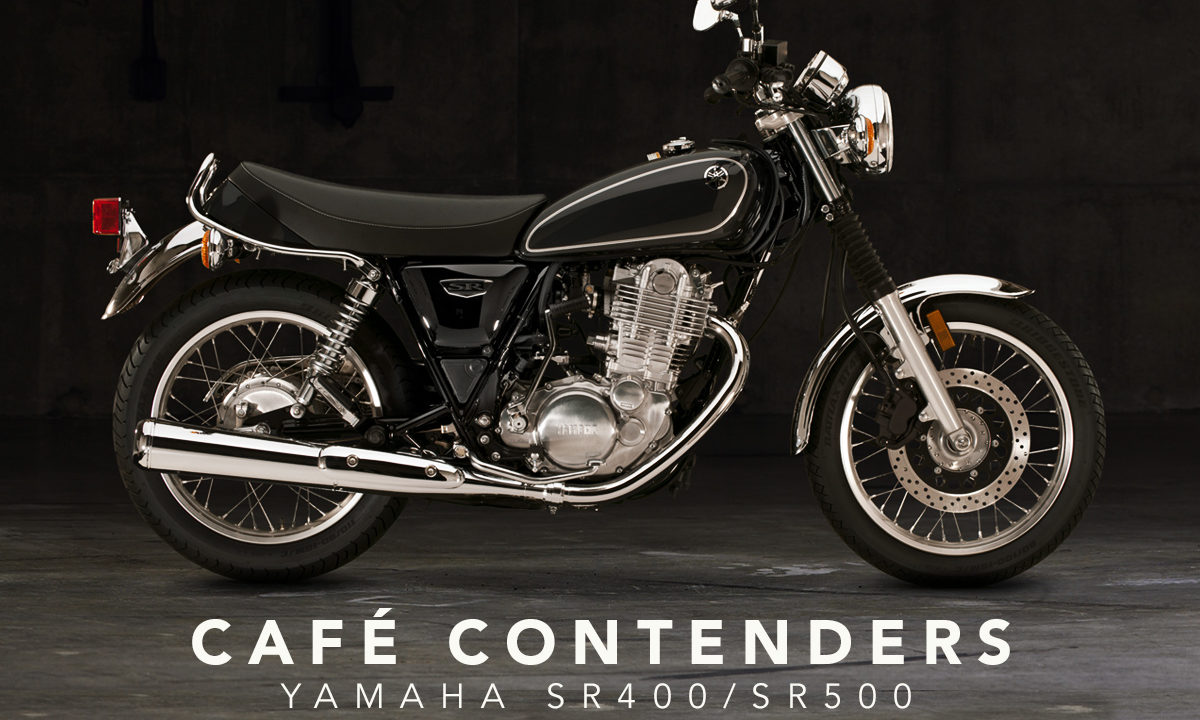


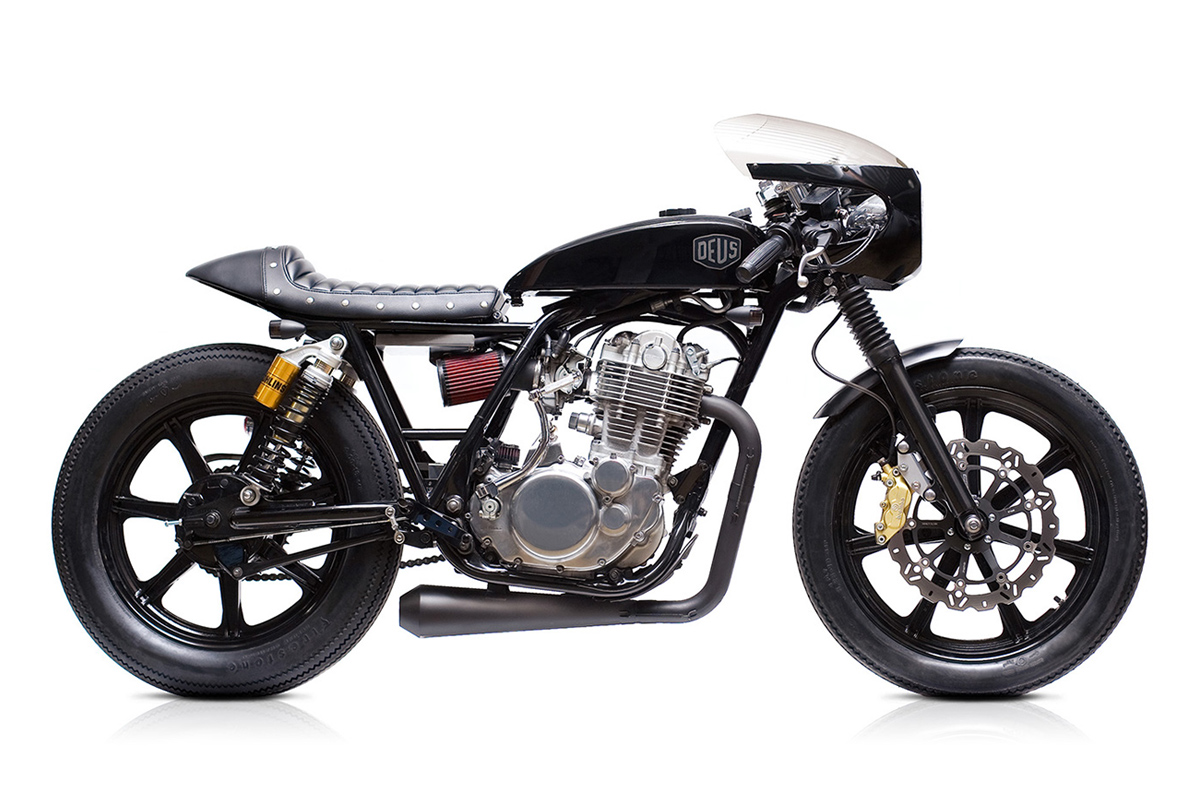



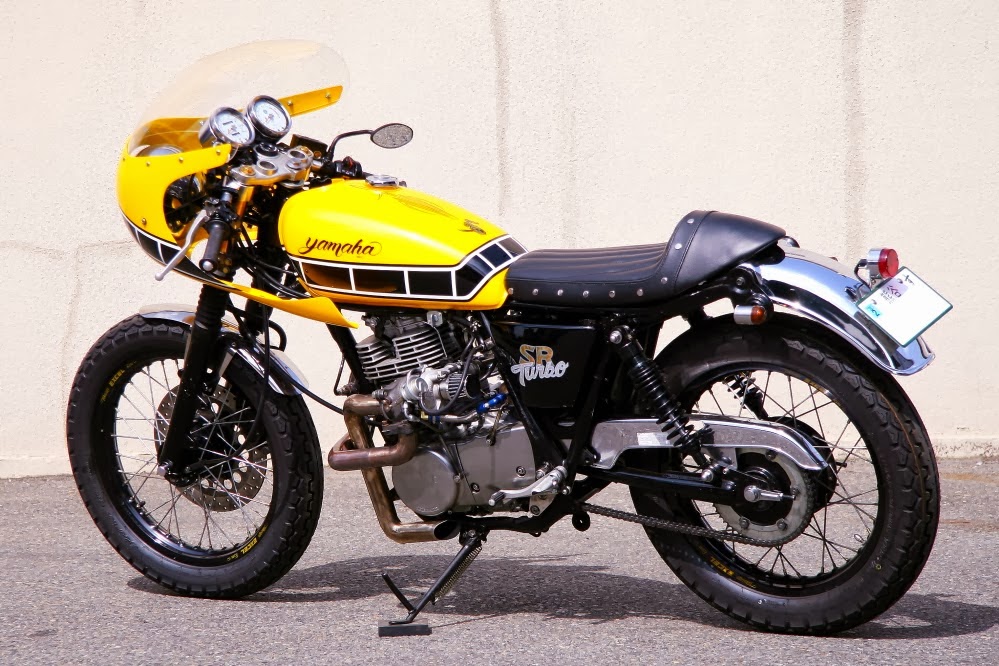



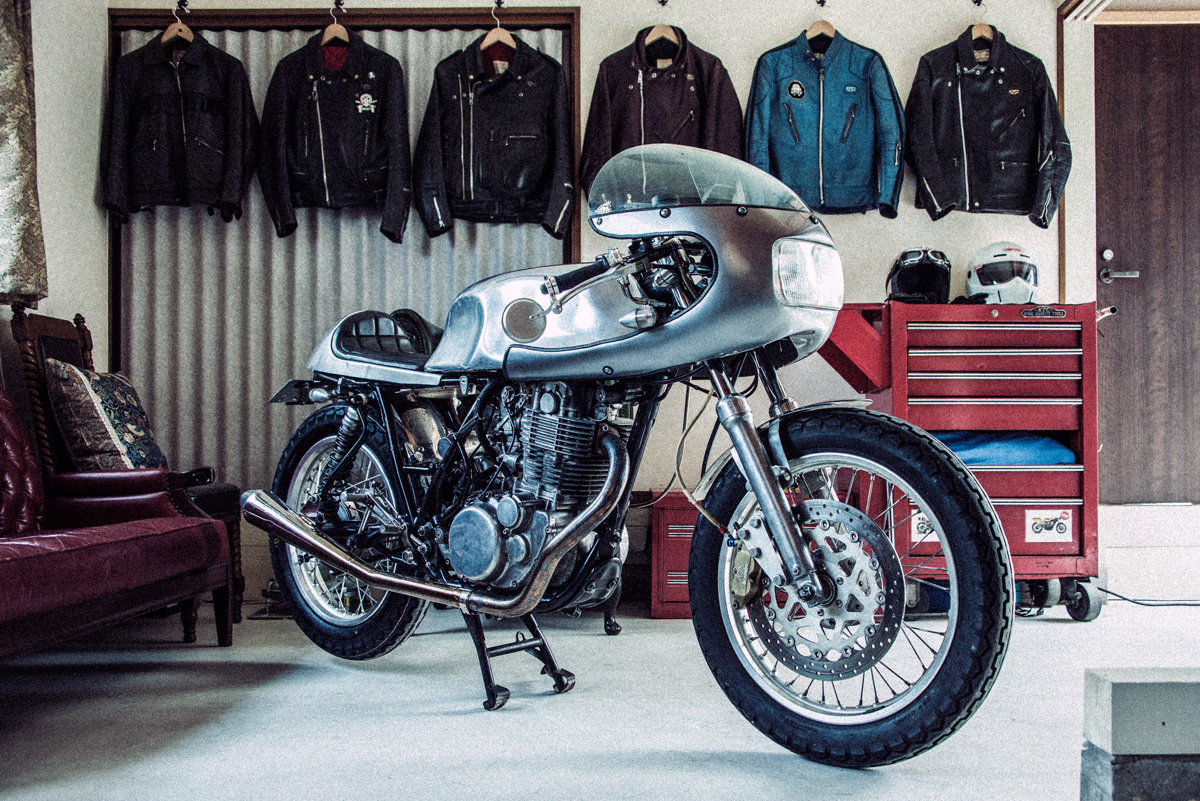
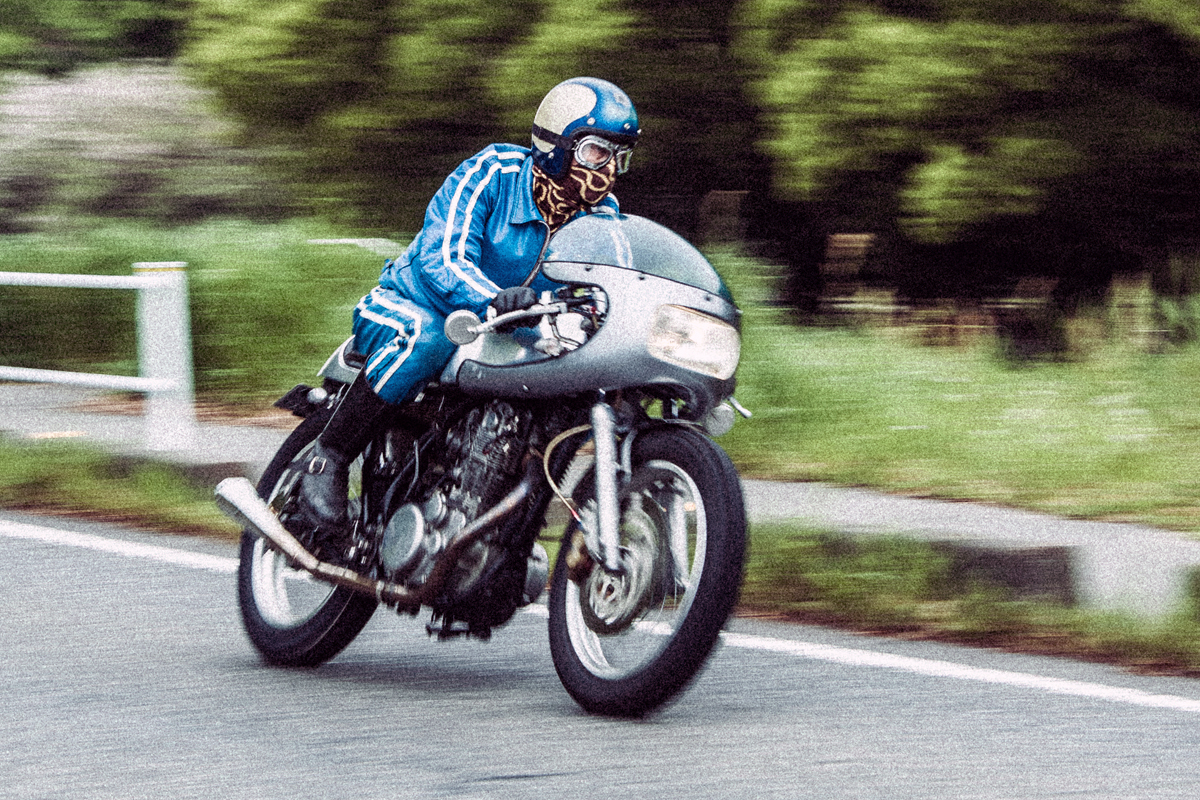


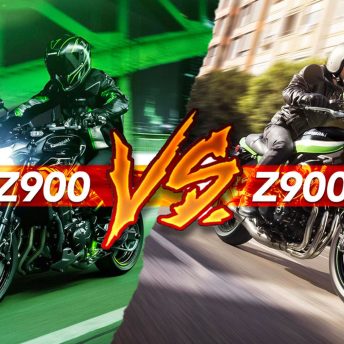



nice article.
you got me hooked
are the parts needed to modify the enine for hp increse readily available?
I’m in Bali, ID
thanks,
Gene
Got to say Thanks for smiling the day, I got a std 64 plate in Black from Scotland not just as a cry for help.. but because it reminded me of when I used to …Borrow.. my elder brothers T.Trophy 250 sport.. O.K so I may have forgoten to ask him. Anone its just such a low tech comfort blanket for Grandad. My lad has his CB1000 R but for me its the shear innocense of me yam.. dont even have to be vaccinated to ride it. Whilst strippin it down and addin a turbo is not for me I think having an old spec baffle exhaust and losin the throttle restrictor would make that suttle difference. Since, as we approach the watershed demise of I.C engine, I think she will make a great companion along with me anti dribble pillow. So I will try and search out some of those spares. Cheers for good article. Phill